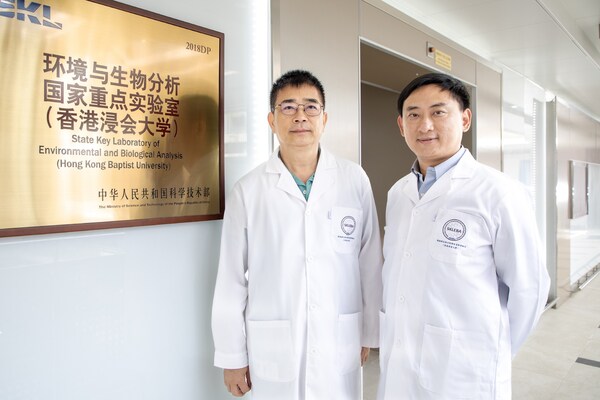HONG KONG,Aug. 27,2024 -- A research team led by Hong Kong Baptist University (HKBU) has discovered that phosphocholine,an important component in the body's metabolism,could counteract the adverse effects of PM2.5 toxicity on lung cells. This discovery highlights the therapeutic potential of phosphocholine in treatinglung diseasesassociated with PM2.5 such as asthma,chronic obstructivepulmonary disease and lung cancer,and contributes to developing health measures against air pollution.
The research findings have been published in the international academic journalProceedings of the National Academy of Sciences.
PM2.5 increases health risks
The World Health Organisation has linked air pollution to an estimated seven million deaths annually,and recognising it as the leading environmental risk factor globally. PM2.5,a major air pollutant,increases the risk of health problems such as heart and lung diseases. Every type of PM2.5 component possesses distinct impactson human health. However,the understanding ofthe toxicity effects of individual PM2.5 components remains limited,and the respective preventive solutions for PM2.5-associated health problems are lacking.
To understand the effects of different PM2.5 componentson the underlying cell metabolism associated with lung diseases,a team led by Professor Cai Zongwei,Chair Professor of the Department of Chemistry and Director of the State Key Laboratory of Environmental and Biological Analysis,and Dr Yang Zhu,Assistant Professor of the Department of Biology at HKBU,analysed a total of 82 components in PM2.5 samples collected from Taiyuanin Shanxi Province and Guangzhouin Guangdong Provincebetween 2017 and 2018.
It was found that the overall PM2.5 profiles were similar in both cities. Inorganic ions are the most abundant pollutants,followed by metals and organic compounds polycyclic aromatic hydrocarbons (PAHs). However,a large difference was observed in the relative proportions of PAHs and their derivatives.
PM2.5 composition contributes to toxicity
The research team discovered that the proportion of PAHs was significantly higher in Taiyuan,especially during the heating season. Since the abundance of PAHs is closely associated with coal combustion,the result suggestedthat coal combustion was one of the major sources of PM2.5in the city. Conversely,the seasonal varianceof PAHs in Guangzhou was significantly lower. Traffic emissions were the predominant PM2.5 in Guangzhou.
Given the disparity in pollutant composition,the research team conducted toxicity and health risk analysis of PM2.5 samples from both cities. A cytotoxicity test revealed that the PM2.5 from winter Taiyuan exhibited much stronger toxicity than the samples fromGuangzhou or from other seasons of Taiyuan with the same PM2.5 concentration,as indicated by cell viability which measures the proportion of healthy living cells. Assessment using the incremental lifetime cancer risk model,which estimates increased cancer risk from carcinogen exposure,highlighted that the regional difference in cancer risks linked to PAHs and its derivatives nitro-PAHs' concentration was much higher than the variation in overall PM2.5 concentration. These findingsunderscore that PM2.5 toxicity cannot be solely attributed to its concentration but also to its composition.
Phosphocholine counteracts PM2.5 toxicity
The research team further employed correlation analysis to examine the impact of specific PM2.5 components on metabolic alterations in lung cells,and identified 11 metabolites that showed a significant correlation with PM2.5 components. Among these metabolites,the researchers focused on the functions of eight oneswhoseamount reduced significantly after PM2.5 exposure. Subsequent experiments demonstrated that only supplementing phosphocholineto PM2.5-exposed cells was effective in both rescuingcell viability and stimulatingadenosine triphosphate (ATP) production. ATP is a critical molecule for energy storage,which provides the energy needed for a wide range of cellular processes within living cells.
Under normal circumstances,lung cellsprimarily rely on glucose for energy production. However,PM2.5 conditions might impair energy supply from glucose. Fatty acid oxidation is a process in cells that breaks down fatty acids to generate energy. Under normal conditions,the utilisation of fatty acid oxidation pathway contributes minimally to energy production in lung cells. It was found that phosphocholinecan reprogramme cellular metabolism to increase fatty acid oxidation to meet the shortfall in energy supply during the PM2.5 challenge,which helps to alleviate cellular dysfunction induced by PM2.5.
Professor Cai said: "Our findings highlighted the potential of phosphocholine as a therapeutic agent for lung diseases associated with PM2.5. As air pollution caused by PM2.5 has been recognised as a significant global health risk factor,our discovery provides the prospect of developing novel treatmentsfor related health issues,potentially helping to address this public health challenge."
In future,the research may also contribute to the development of diagnosis protocol for lung diseases caused by PM2.5 apart from its potential as a therapeutic agent.

Professor Cai Zongwei,Chair Professor of the Department of Chemistry and Director of the State Key Laboratory of Environmental and Biological Analysis (left),and Dr Yang Zhu,Assistant Professor of the Department of Biology at HKBU (right),discover the potential of phosphocholine in counteracting PM2.5 toxicity in the lungs.